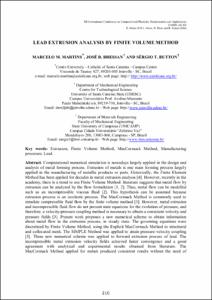Mostra el registre d'ítem simple
Lead extrusion analysis by finite volume method
| dc.contributor.author | Martins, Marcelo M. |
| dc.contributor.author | Bressan, Jose D. |
| dc.contributor.author | Button, Sergio T. |
| dc.date.accessioned | 2020-03-30T15:24:53Z |
| dc.date.available | 2020-03-30T15:24:53Z |
| dc.date.issued | 2013 |
| dc.identifier.isbn | 978-84-941531-5-0 |
| dc.identifier.uri | http://hdl.handle.net/2117/182299 |
| dc.description.abstract | Computational numerical simulation is nowadays largely applied in the design and analysis of metal forming process. Extrusion of metals is one main forming process largely applied in the manufacturing of metallic products or parts. Historically, the Finite Element Method has been applied for decades in metal extrusion analysis [4]. However, recently in the academy, there is a trend to use Finite Volume Method: literature suggests that metal flow by extrusion can be analyzed by the flow formulation [1, 2]. Thus, metal flow can be modelled such us an incompressible viscous fluid [2]. This hypothesis can be assumed because extrusion process is an isochoric process. The MacCormack Method is commonly used to simulate compressible fluid flow by the finite volume method [3]. However, metal extrusion and incompressible fluid flow do not present state equations for the evolution of pressure, and therefore, a velocity-pressure coupling method is necessary to obtain a consistent velocity and pressure fields [3]. Present work proposes a new numerical scheme to obtain information about metal flow in the extrusion process, in steady state. The governing equations were discretized by Finite Volume Method, using the Explicit MacCormack Method to structured and collocated mesh. The SIMPLE Method was applied to attain pressure-velocity coupling [3]. These new numerical scheme was applied to forward extrusion process of lead. The incompressible metal extrusion velocity fields achieved faster convergence and a good agreement with analytical and experimental results obtained from literature. The MacCormack Method applied for metals produced consistent results without the need of artificial viscosity as employed by the compressible flow simulation approaches. Furthermore, the present numerical results also suggest that MacCormack Method and SIMPLE can be applied in the solution of metal forming processes besides the traditional application for compressible fluid flow. |
| dc.format.extent | 11 p. |
| dc.language.iso | eng |
| dc.publisher | CIMNE |
| dc.rights | Open Access |
| dc.subject | Àrees temàtiques de la UPC::Matemàtiques i estadística::Anàlisi numèrica::Mètodes en elements finits |
| dc.subject.lcsh | Finite element method |
| dc.subject.lcsh | Plasticity -- Mathematical models |
| dc.subject.lcsh | Plasticity |
| dc.subject.other | Extrusion; Finite Volume Method; MacCormack Method; Manufacturing processes; Lead |
| dc.title | Lead extrusion analysis by finite volume method |
| dc.type | Conference report |
| dc.subject.lemac | Elements finits, Mètode dels |
| dc.subject.lemac | Plasticitat -- Models matemàtics |
| dc.subject.lemac | Plasticitat |
| dc.rights.access | Open Access |
| local.citation.contributor | COMPLAS XII |
| local.citation.publicationName | COMPLAS XII : proceedings of the XII International Conference on Computational Plasticity : fundamentals and applications |
| local.citation.startingPage | 210 |
| local.citation.endingPage | 220 |


